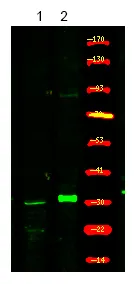
Size:50μL Price:$118
Size:100μL Price:$220
Size:200μL Price:$380
Application:WB
Reactivity:Human,Mouse,Rat
Conjugate:Unconjugated
Optional conjugates: Biotin, FITC (free of charge). See other 26 conjugates.
Gene Name:XPA
Summary
| Production Name | XPA (Phospho-Ser196) Rabbit Polyclonal Antibody |
| Description | Rabbit polyclonal Antibody |
| Host | Rabbit |
| Application | WB |
| Reactivity | Human,Mouse,Rat |
Performance
| Conjugation | Unconjugated |
| Modification | Phosphorylated |
| Isotype | IgG |
| Clonality | Polyclonal |
| Form | Liquid |
| Storage | Store at 4°C short term. Aliquot and store at -20°C long term. Avoid freeze/thaw cycles. |
| Buffer | Liquid in PBS containing 50% glycerol, 0.5% protective protein and 0.02% New type preservative N. |
| Purification | Affinity purification |
Immunogen
| Gene Name | XPA |
| Alternative Names | DNA repair protein complementing XP-A cells (Xeroderma pigmentosum group A-complementing protein) |
| Gene ID | 7507 |
| SwissProt ID | P23025 |
Application
| Dilution Ratio | WB 1:500-1:2000 |
| Molecular Weight | 30kDa |
Background
disease:Defects in XPA are a cause of xeroderma pigmentosum complementation group A (XP-A) [MIM:278700]; also known as xeroderma pigmentosum type 1 (XP1). XP-A is a rare human autosomal recessive disease characterized by solar sensitivity, high predisposition for developing cancers on areas exposed to sunlight and, in some cases, neurological abnormalities. Group A patients show the most severe skin symptoms and progressive neurological disorders.,function:Involved in DNA excision repair. Initiates repair by binding to damaged sites with various affinities, depending on the photoproduct and the transcriptional state of the region. Required for UV-induced CHK1 phosphorylation and the recruitment of CEP164 to cyclobutane pyrimidine dimmers (CPD), sites of DNA damage after UV irradiation.,PTM:Phosphorylated upon DNA damage, probably by ATM or ATR.,similarity:Belongs to the XPA family.,subunit:Interacts with XAB1 and RPA1. Interacts (via N-terminus) with CEP164 upon UV irradiation.,tissue specificity:Expressed in various cell lines and in skin fibroblasts.,
Research Area
Nucleotide excision repair;
